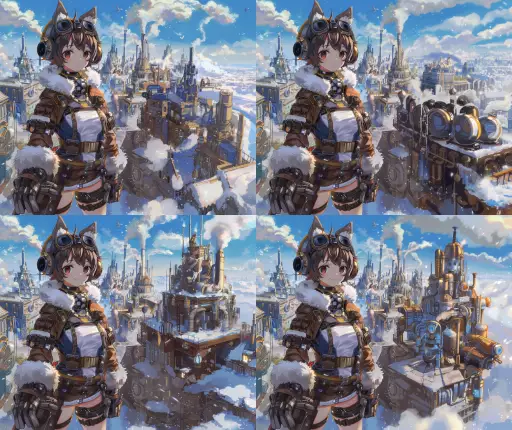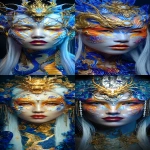Explore the Best AI Image Gallery

Beyond the Canvas: How Edge Computing is Redefining Creative Expression
The realm of creativity is constantly evolving, driven by technological advancements that push the boundaries of artistic expression. One such transformative force is edge computing, a paradigm shift in how data is processed and utilized. By bringing computation closer to the source of data, edge computing unlocks unprecedented opportunities for creatives across various disciplines.
Edge computing empowers artists, designers, and innovators with real-time responsiveness, immersive experiences, and decentralized control. Lets delve into the exciting world of edge computing and its impact on the creative industry.
Applications at the Edge: Reimagining Creative Processes
- Interactive Art Installations: Imagine art installations that respond dynamically to viewer presence and interaction, blurring the lines between observer and participant. Edge computing enables real-time data processing from sensors, allowing for immersive and personalized experiences.
- Augmented Reality (AR) Design Tools: Architects, designers, and engineers can utilize AR applications powered by edge computing to visualize their creations in real-world environments. Edge devices process spatial data and render interactive 3D models, facilitating collaborative design processes and enhancing spatial understanding.
- Personalized Music Experiences: Edge computing empowers artists to create dynamic music compositions that adapt to the listeners mood, environment, or even physiological responses. By processing real-time audio and sensor data, edge devices can generate personalized soundtracks, enhancing emotional engagement and artistic expression.
- Live Performance Enhancements: Musicians and performers can leverage edge computing for interactive stage setups, incorporating real-time audience feedback, synchronized visuals, and dynamic lighting effects. This fusion of technology and performance elevates the live experience to new levels of interactivity.
Ethical Considerations: Navigating Uncharted Territory
As with any emerging technology, edge computing in the creative industry raises ethical considerations that require careful attention:
- Data Privacy and Security: Edge devices collect vast amounts of user data, necessitating robust security measures to protect sensitive information. Transparent data governance policies and user consent mechanisms are crucial to ensure ethical data handling.
- Algorithmic Bias: AI algorithms used in creative applications can perpetuate societal biases if not carefully designed and monitored. Its essential to address algorithmic bias through diverse datasets, fairness audits, and ongoing evaluation to promote equitable creative outcomes.
- Intellectual Property Rights: The decentralized nature of edge computing raises questions about ownership and attribution in creative works. Establishing clear guidelines for intellectual property rights in collaborative and AI-driven creations is paramount.
Future Trends: The Evolution of Creative Expression
The intersection of edge computing and creativity is poised for continuous evolution, driven by advancements in artificial intelligence, sensor technologies, and network connectivity:
- AI-powered Creativity Tools: Edge devices will increasingly integrate AI algorithms to assist artists in generating ideas, refining concepts, and exploring new creative possibilities. Collaborative platforms powered by edge computing will foster innovation and knowledge sharing among creatives.
- Immersive Sensory Experiences: The convergence of edge computing with virtual reality (VR) and augmented reality (AR) will create immersive sensory experiences that blur the lines between physical and digital realms. Artists will leverage these technologies to design interactive installations, performative art pieces, and personalized storytelling experiences.
- Decentralized Creative Platforms: Edge computing empowers creators to build their own decentralized platforms for sharing, collaborating, and monetizing their work. Blockchain technology integrated with edge networks will enable secure and transparent transactions, fostering a more equitable creative ecosystem.
In conclusion, edge computing is revolutionizing the creative industry by empowering artists, designers, and innovators with unprecedented tools and possibilities. As this technology continues to evolve, we can expect even more innovative applications that push the boundaries of artistic expression and redefine the way we create, experience, and interact with art.


](https://images.ai-img.art/thumbnails/150/269414b0e541026702e9e67c67602c96162f37ff460a388b3b36314c8fc936dd.webp)











](https://images.ai-img.art/thumbnails/150/5197af8969d850e2a43e141d41e482ccbceedebceb2a4caf9f098f943f9d1b0f.webp)



















](https://images.ai-img.art/thumbnails/150/485c8b1c747827bdc9a962f8a1919b3c259b18dd263b260208a1eae19fb85e07.webp)



](https://images.ai-img.art/thumbnails/150/8d1fe5a7a49cfc96747182431a853357913286d89258383caab2d3b4681afcb5.webp)

](https://images.ai-img.art/thumbnails/150/2fbd98ecfc425cfc1597779121e1c0305437067779e9c471eb64ff9615d5be98.webp)
](https://images.ai-img.art/thumbnails/150/3020b8c2b6d9be07e042357107af1de10deb274a41d2b0f332684ad4b532a702.webp)







